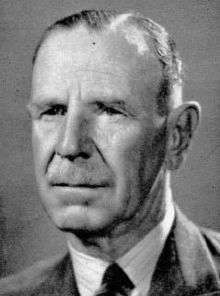Robert Wordsworth
Major-General Robert Harley Wordsworth CB, CBE (21 July 1894 – 22 November 1984) was a British Indian Army officer and an Australian politician.
Robert Wordsworth | |
|---|---|
 | |
| Senator for Tasmania | |
| In office 22 February 1950 – 30 June 1959 | |
| Personal details | |
| Born | 21 July 1894 Collarenebri, New South Wales |
| Died | 22 November 1984 (aged 90) |
| Political party | Liberal |
| Awards | Companion of the Order of the Bath Commander of the Order of the British Empire |
| Military service | |
| Allegiance | |
| Branch/service | British Indian Army |
| Years of service | 1914–1947 |
| Rank | Major General |
| Battles/wars | World War I World War II |
Military career
Born in Collarenebri, New South Wales, Wordsworth was educated at North Sydney Grammar School. He was commissioned into the Australian Imperial Force on 27 August 1914[1] as an officer of 1st Light Horse Regiment.
During World War I Wordsworth served at Gallipoli, Egypt and Palestine between May 1915 and November 1917[2] and was mentioned in dispatches.[3] After transferring to the Indian Army on 3 November 1917, he was appointed to the 16th Cavalry on 7 November 1917.[4] He went on to serve in Waziristan between 1919 and 1921 with his regiment[2] which was amalgamated with the 13th Duke of Connaught's Lancers in June 1921 to form the 13/16th Cavalry which itself was renamed the 6th Duke of Connaught's Own Lancers in July 1922.[2]
Wordsworth was Adjutant and then a Squadron Commander with the regiment during the North West Frontier operations between 1930 and 1931.[5] He was appointed commanding officer of the 6th Duke of Connaught's Own Lancers on 11 June 1939.[1]
Wordsworth also served in World War II. In July 1940 he was appointed commander of the 1st Indian Armoured Brigade, which was renamed 251st Indian Armoured Brigade in October 1941, as part of 1st Indian Armoured Division, later renamed 31st Indian Armoured Division. Promoted Acting Major-General on 28 March 1942,[6] he was appointed commander of the 31st Indian Armoured Division in May 1942. As part of the British 10th Army, his division was stationed in Persia in 1942. At that time, the British 10th Army was part Paiforce (formerly Iraqforce) under the Persia and Iraq Command. In December 1944 he was appointed Director of Armoured Fighting Vehicles, India. He was made a Commander of the Order of the British Empire in 1943, promoted to major-general on 6 June 1944[7] and appointed a Companion of the Order of the Bath in 1945.[8]
Retirement
He retired to Australia in 1947 and became a farmer at Westbury in Tasmania. In 1949, he was elected to the Australian Senate as a Liberal Senator for Tasmania. He was defeated in 1958. In 1962, he was appointed Administrator of Norfolk Island, serving until 1964. Wordsworth died in 1984.[9] His son, David Wordsworth, was a member of the Western Australian Legislative Council.[10]
References
- October 1939 Indian Army List
- Indian Army List Supplement 1941
- London Gazette 12 January 1918
- January 1919 Indian Army List
- July 1930 & April 1932 Indian Army List
- London Gazette 10 July 1942
- London Gazette 8 August 1944
- London Gazette 1 January 1945
- Carr, Adam (2008). "Australian Election Archive". Psephos, Adam Carr's Election Archive. Retrieved 24 November 2008.
- David John Wordsworth – Biographical Register of Members of the Parliament of Western Australia. Retrieved 22 May 2016.